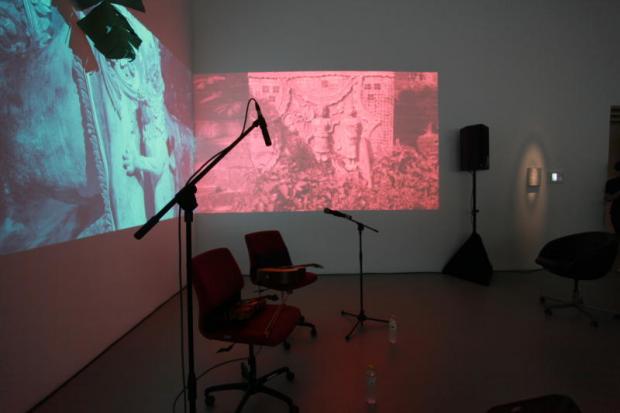Entering Chai Siris' exhibition at Gallery VER is in many ways like penetrating a spirit house. Once shuffled through the door, visitors find themselves plunged in semi-obscurity, surrounded by life-size banana trees and landscape views that cover entire walls.
Quickly, the room becomes an alternative dimension, one populated by ghosts -- amicable and alluring enough for one to wish to converse with them, but retaining sufficient mystery to keep the hairs on the back of your neck standing up.
The exhibition "Landscape And A Man Who Eats The Sun" is indeed a shrine in which personal and collective memories are intertwined. Featuring Chai Siris' works from 2007-2017 -- some of which he revisited for this event -- the show subtly ties in with Thailand's uncertainty-filled mood through the exploration of landscapes and what comes after death.
"I wished to imagine what became of King Bhumibol's soul once it left his body," the artist said, commenting on his latest pieces, The King and Rebirth.
In the past year, several artists have dedicated paintings and sculptures to the late monarch but Chai Siris takes a different direction altogether, choosing to look ahead rather than back.
While The King consists of two photographs of an unknown location in the jungle, where spirits of kings are believed to rest in peace, Rebirth delves into the idea of reincarnation. A dual-entry, two-toned video, it juxtaposes serene forest shots with equally tranquil images of a man lying naked, asleep during daytime.
"His spirit could be reincarnated as any of these living beings," Chai added. The meditative work raises questions -- "Where will I go? What will I become?" which apply to each and everyone.
On the opposite side of the room, two black-and-white videos of scenery, a mountain and the seaside, re-create an idea of what the afterlife might look like. The images are inverted, mountains growing from the sky and waves that could come crashing down anytime -- as if one had just awaken after death and saw the Earth from an entirely new perspective.
An admirer of Japanese painter Hokusai's works, Chai Siris travelled to the locations where the master created his iconic scenes, paying homage to artistic transmissions.
Two smaller projection screens also portray the collective memories of Thais in different settings. In October 2015, the artist travelled from his hometown Samut Prakan to his current home in Chiang Mai in a day, recording every photograph of the royal family he came across.
The diary-like successive screening of all 97 photographs he collected not only shows the prevalence of such images in Thais' collective imagery but also how accustomed we have grown to them, to the point of looking without seeing.
"This is the first time that I paid attention to the sheer number of these pictures. It's astounding that I could consume nearly 100 of them in a single day," Chai said.
From his personal archive, Chai picked a series of photographs taken in 2007 by homeless people living in and around Sanam Luang. The location in itself is key, as Sanam Luang traditionally serves as ceremonial grounds for royal events but is also home to some of the country's most marginalised communities.
The artist was then working with the Issarachon Foundation, when he gave disposable cameras to homeless people he encountered and interacted with.
"I wanted to gain insights into their lifestyles when I wasn't around," he said.
Often portraying themselves with their families and friends, the photographs' owners were able to keep copies of them, as souvenirs of their "home" and community.
Home isn't just a physical space in Chai Siris' works, but a fluid set of customs, values and memories that transcend tangible boundaries.
It's only as an adult that Chai learned that his mother was in fact Burmese and crossed the Salween River as a child, fleeing the 1962 coup d'etat in Myanmar. Her real name Reena became that of the central character of a feature film the artist is working on, an ongoing project twice hindered due to lack of funding and censorship, as it deals with sensitive political themes.
Excerpts of the script are hung on the gallery walls -- excerpts in which Reena, a ghost, interacts with humans.
"Reena is ghostlike to me, like my mother's past, which I knew nothing about," he explained. Still, such kind of past life has direct consequences on the present.
Trauma, like the one portrayed in Majestic Syndrome, a 2016 video installation, is unshakeable. A parody of a 1925 medical film Acute Encephalitis Lethargica about a growing sleeping disease, the work pictures a woman falling and being picked up by a man, before dropping to the ground again.
The actress in Chai Siris' video is Aum Neko, a prominent political activist who fled Thailand after being charged with lese-majeste. "Aum is in reality a very pretty and sexy woman," the artist added, having wished to showcase her beauty.
Although she has relocated to another country, it seems as though past sicknesses of the land she grew up in has caught up with Aum, the video acting in the same time as a metaphor for Thailand's political woes. Even as the country is back on its feet, it soon crumbles down again, as if paralysed and unable to move forward.
Political, social and personal spheres are presented in no particular order in this exhibition -- one work dialoguing with another and viewers' thoughts bounce on the walls as a result.
The artist's childhood memories and affection for movies envelop the space, through the use of banana trees as allegories.
Having grown up surrounded by a garden, his early memories of cinema involved outdoor screenings of horror films, in which ghosts were often associated with banana trees. During the screenings, the physical landscape of the garden and the cinematic landscape would blend.
Although his earlier shows featured potted banana trees, which Chai Siris would then replant in the forest once the exhibition was over, the ones at Gallery VER are uprooted and decaying.
Even as such, the artist recreates the trees' natural environment through recorded sounds of a jungle -- acting as a soundtrack that links his works together, while the room's obscurity mimics the atmosphere of a cinema.
While borders are a central theme of Chai Siris' work -- the frontier between countries, cultures and sexes, the boundary between life and death -- in his artistic practice, he commonly blurs lines. Fiction and reality are interlaced.
"I look at frontiers as places of connection and exchanges rather than partition lines," he said.

Majestic Syndrome (2016). Chai Siris

Rebirth (2017). Photos courtesy of the artist

